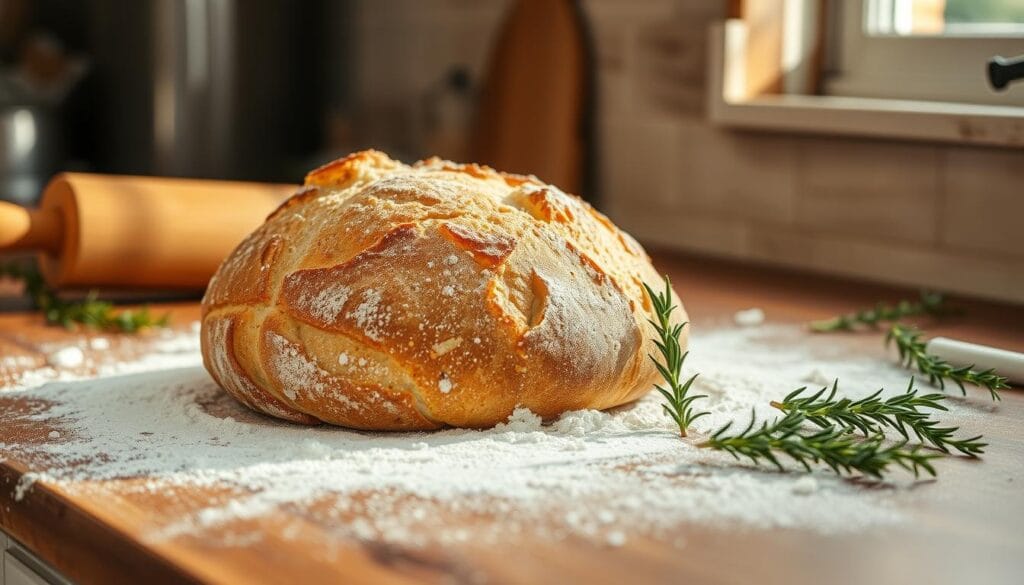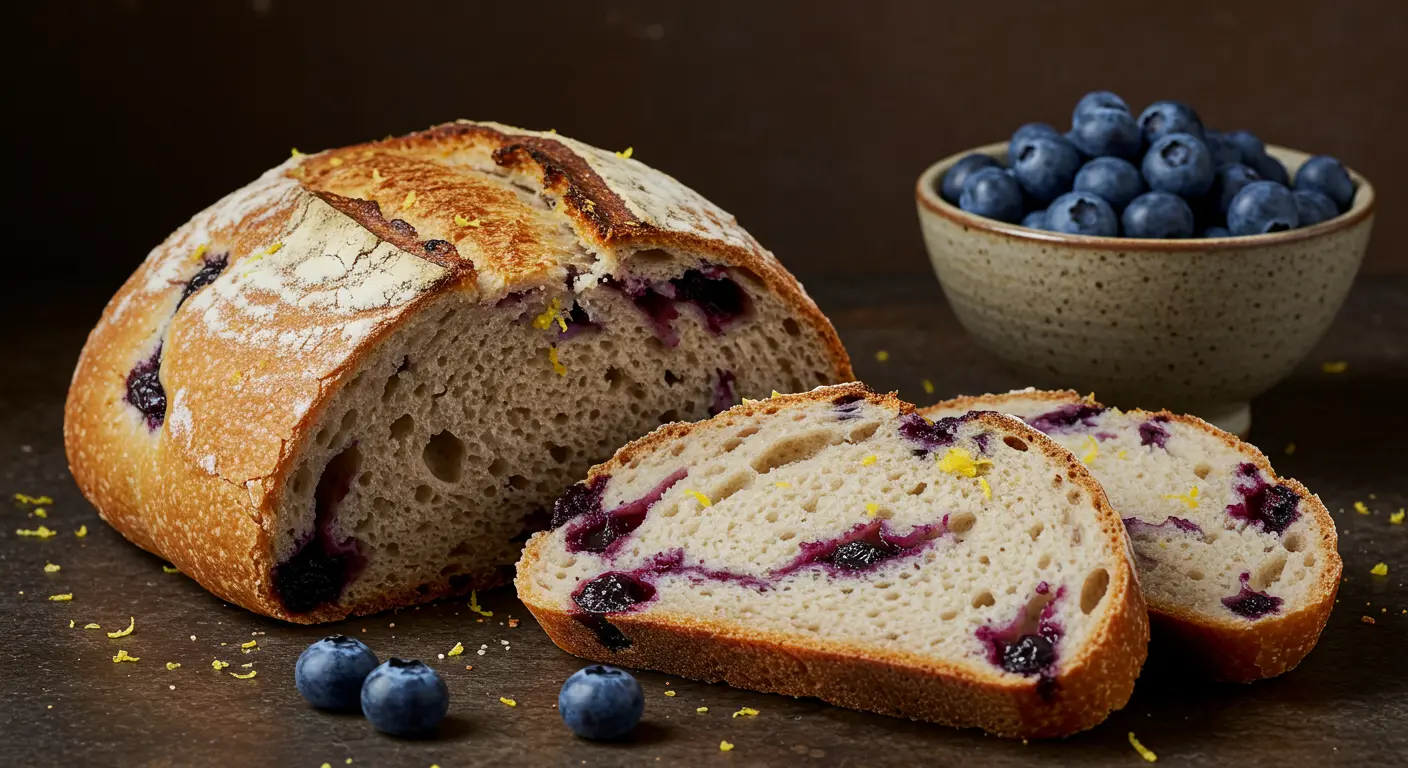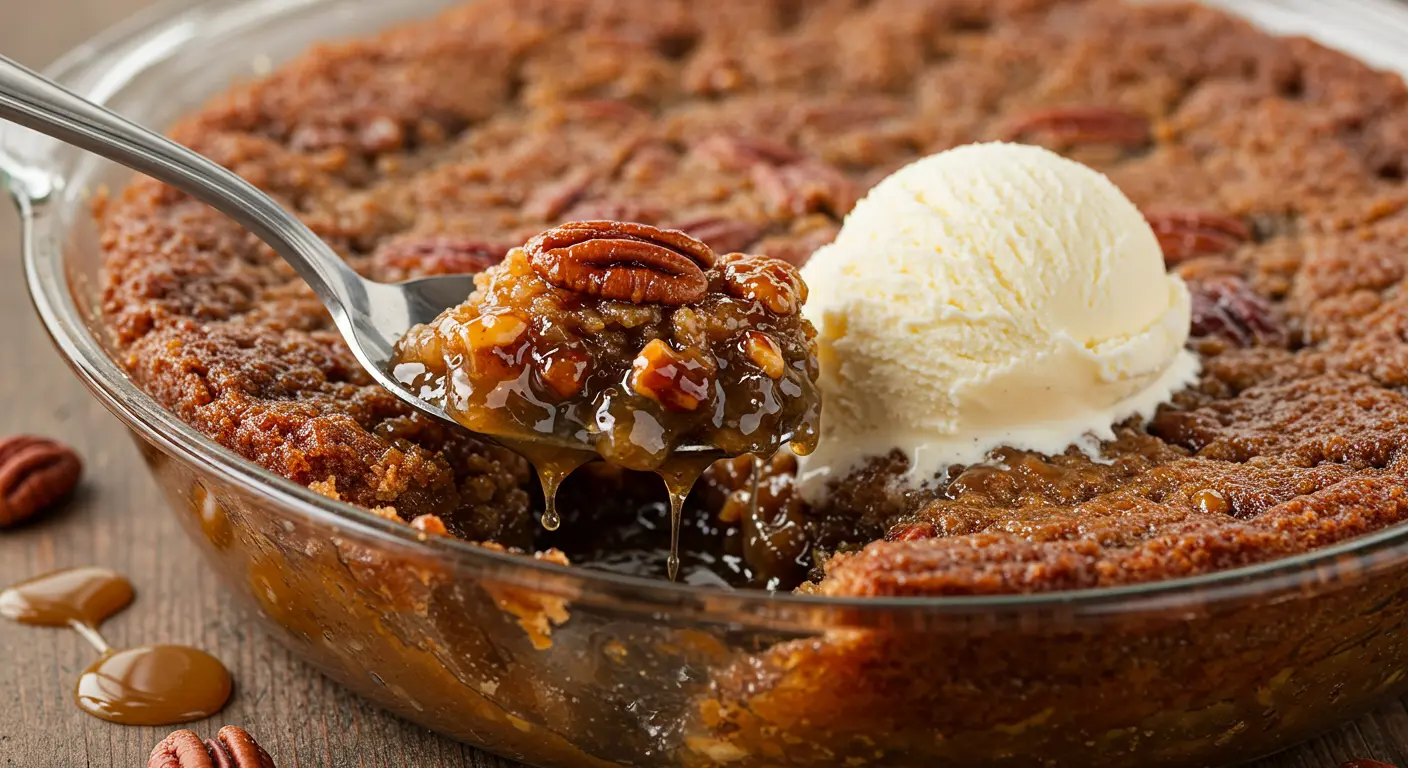Baking bread is deeply comforting. As you knead, the dough changes, becoming alive and beautiful. This crusty Italian bread recipe captures that magic, filling your home with fresh bread smells.
It’s not just about ingredients. It’s about making memories, sharing meals, and enjoying the homemade bread-making journey. Who doesn’t love the satisfying sound of a crust breaking?
Many bakers have shared this Irresistible Crusty Italian Bread Recipe online, praising its simplicity and taste. It needs just a few things: bread flour, water, yeast, salt, sugar, and olive oil. Together, they make a delicious loaf that can make any meal better. Enjoy it with olive oil and balsamic vinegar or butter for an extra treat.
What Makes Italian Bread Unique?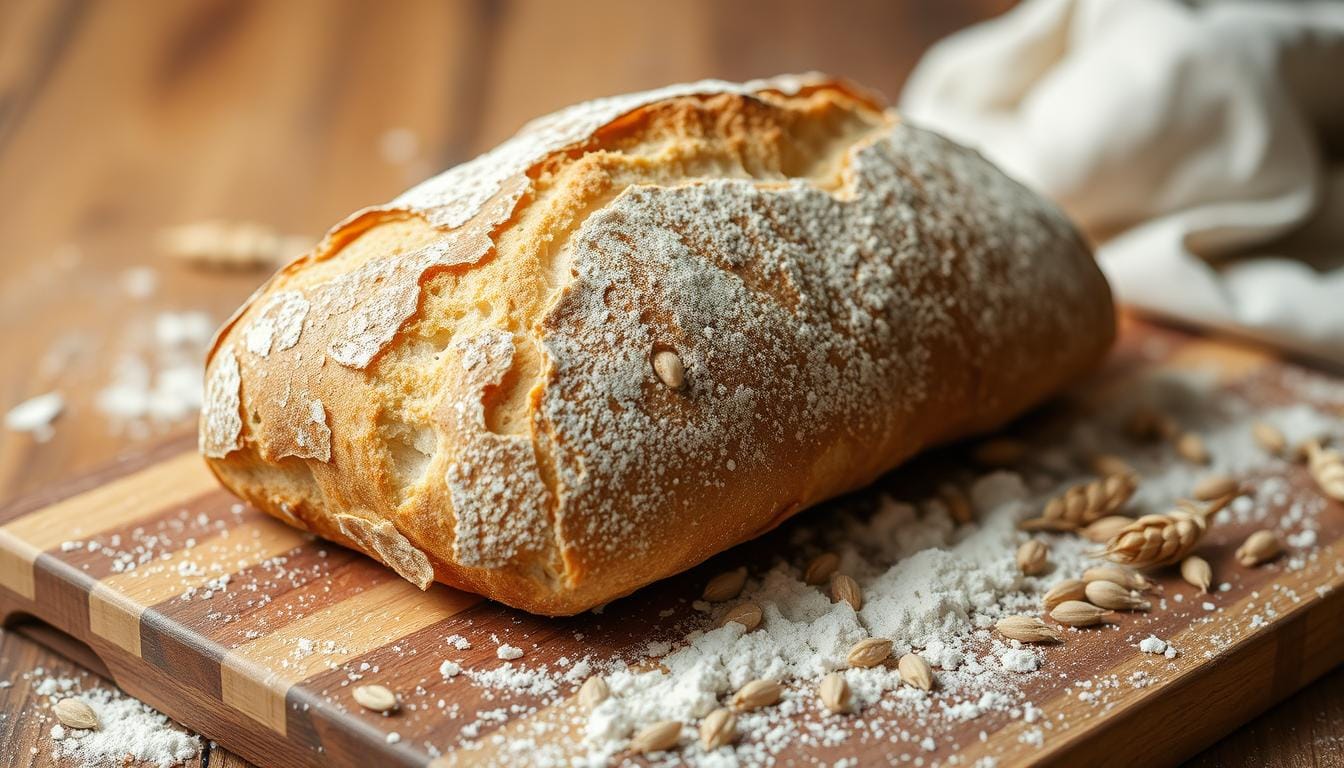
Italian bread stands out because of its thick, chewy crust. This gives it a satisfying bite. In contrast, French bread has a lighter, airier texture. This difference shows why Italian bread is so beloved in Italy.
Differences Between Italian and French Bread
Let’s look at some key differences:
Feature | Italian Bread | French Bread |
Crust | Thick and chewy | Thin and crisp |
Crumble | Dense and hearty | Light and airy |
Flavor | Rich and robust | Subtle and soft |
Baking Techniques | Hands-on traditional methods | Delicate techniques |
Characteristics of Rustic Italian Bread
Rustic Italian bread is made with wholesome ingredients and traditional methods. Allow the dough to rise for 1 to 2 hours until it doubles in size. Kneading is crucial for the right texture.
The result is a loaf with a crisp crust and an irresistible aroma. Many Italian breads are baked in a steam bath to get that crispy crust. This makes the bread even more enjoyable to eat.
Quick Recipe Card
Crusty Italian Bread Recipe
- Prep Time: 15 minutes
- Rise Time: 1-2 hours
- Bake Time: 45-50 minutes
- Total Time: 13-19 hours
- Difficulty: Easy
- Servings: 1 large loaf (8-10 slices)
Nutritional Information (per slice)
- Calories: 120
- Carbohydrates: 25g
- Protein: 4g
- Fat: 1g
Equipment
- Large mixing bowl
- Dutch oven or heavy baking pot with lid
- Parchment paper
- Kitchen scale (recommended)
- Proofing basket (optional)
Ingredients
- 500g (4 cups) bread flour
- 10g (2 tsp) salt
- 2g (1/2 tsp) active dry yeast
- 350ml (1½ cups) lukewarm water
Brief Instructions
- Mix ingredients
- Allow long, slow fermentation
- Shape and bake in hot Dutch oven
- Cool and enjoy your crusty Italian bread!
This craft not only improves your cooking skills. It also lets you share delicious homemade bread with loved ones. So, gather your ingredients and let’s start baking
Essential Ingredients for Italian Bread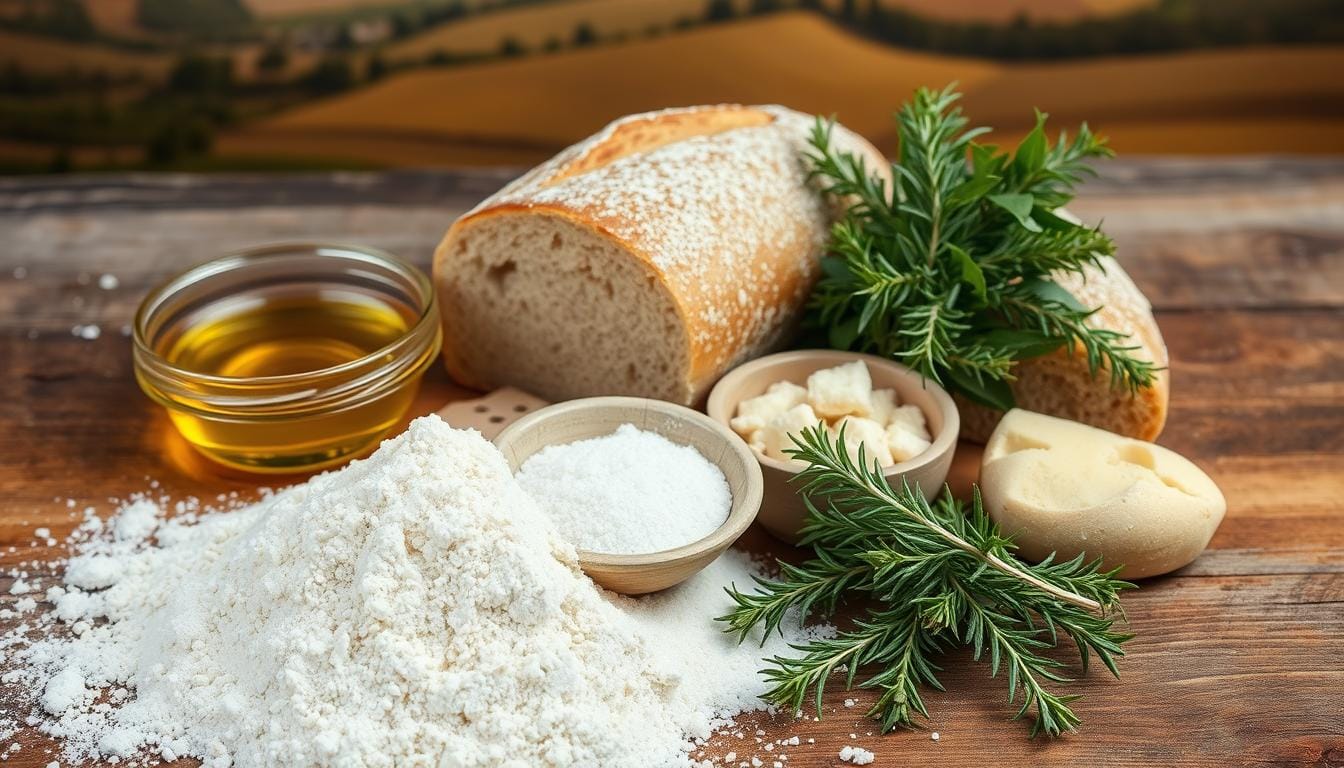
Making authentic Italian bread starts with knowing the key ingredients. The choice and quality of ingredients play a crucial role in the final outcome. Let’s explore the main parts that make up this beloved bread.
Choosing the Right Flour: Bread Flour vs. All-Purpose
The type of flour you use can change your bread’s texture. Bread flour has more protein, making it chewy and perfect for a crusty bread. All-purpose flour is more flexible but doesn’t have the same strength, making the bread softer.
Choosing bread flour is key to getting that rustic Italian bread everyone loves.
The Role of Yeast in Bread Making
Yeast is crucial for making the dough rise and develop flavor. Active dry yeast is a favorite among home bakers. It needs a few minutes in warm water to activate.
Temperature is important for yeast to work well. Aim for 110°F to 115°F for the best results. This ensures your bread turns out right, capturing the true taste of Italian cuisine.
Importance of Water Temperature
Water temperature is also vital in bread making. Water that’s too hot can kill the yeast, while cold water slows down rising. Aim for warm water at 110°F.
This warmth helps activate the yeast and improves the dough’s consistency and taste. Getting the water temperature right can make your homemade bread even better.
Substitution Options
- Gluten-free flour blend
- Instant yeast (adjust quantity)
- Sea salt alternatives
- Whole wheat flour (partial substitution)
Perfecting the Crusty Italian Bread Recipe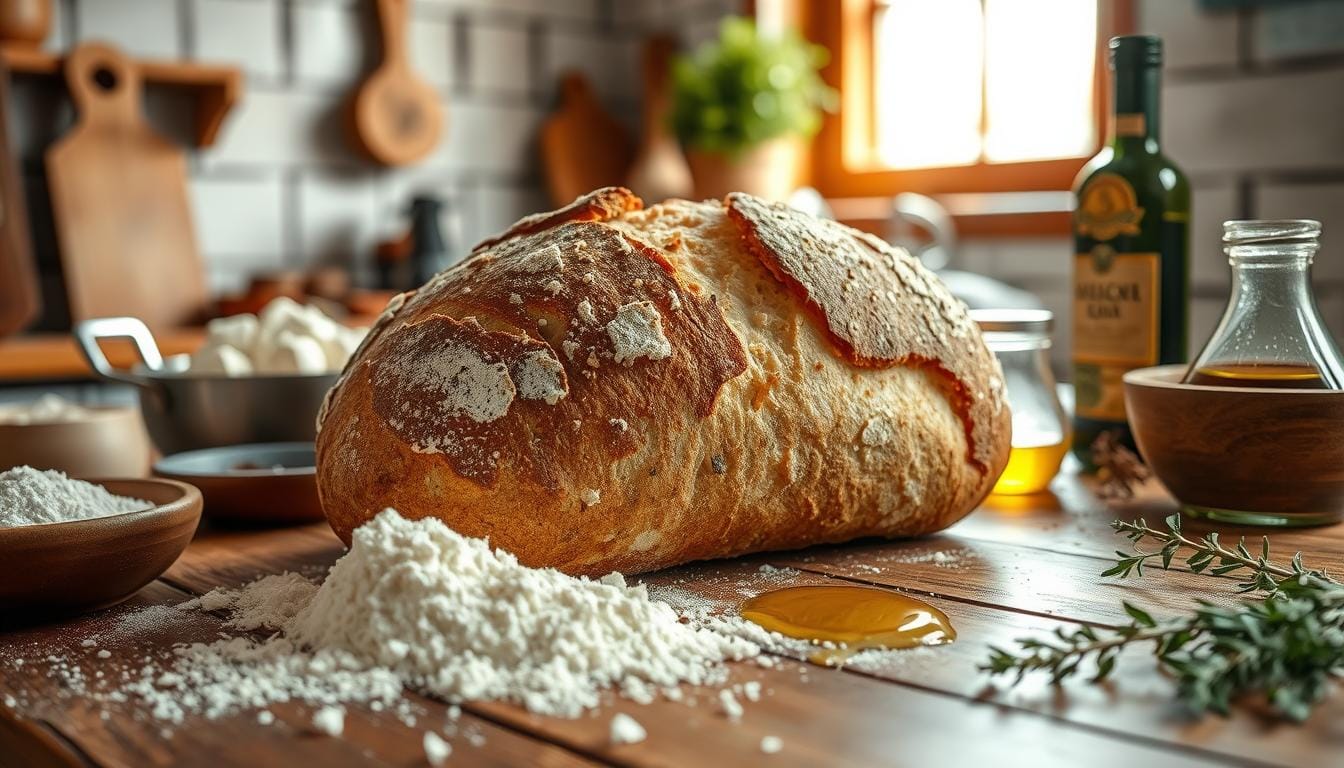
Making the perfect crusty Italian bread needs focus and careful baking steps. You can follow a clear guide to create a tasty loaf with a crispy crust. This recipe uses special flour mixes and baking methods for the best results.
Step-by-Step Instructions for Making Italian Bread
- Start by mixing 100 grams of strong flour, 100 grams of whole meal spelt flour, and 300 grams of wheat flour type ‘0’ in a big bowl.
- Then, add 1 teaspoon of salt and 2 grams of dehydrated beer yeast to the flour mix.
- Gradually add water until the dough reaches a wet, sticky consistency. Don’t knead; just mix until it’s combined.
- Cover the bowl and let the dough rise for 4 hours at room temperature, or 20 hours in the fridge for a deeper flavor.
- After rising, shape the dough into a round loaf and let it rest for an additional 30 minutes.
- Preheat your oven to 500°F (approximately 260°C). Place a Dutch oven inside to heat up for steam.
- Put the dough in the preheated Dutch oven, cover it, and bake for 30 minutes.
- Then, remove the lid and lower the temperature to 200 degrees C for 15 more minutes. For the last 5 minutes, crack the oven door open to get a crispy crust.
- Finally, cool the bread on a wire grid to ensure even texture by allowing air to circulate around it.
Tips for Achieving a Crispy Crust
- Using malt or honey in the dough recipe adds a distinctive flavor and helps achieve that sought-after crusty texture.
- Adding 2-3 cups of hot water in an ovenproof bowl while baking provides steam, assisting in the crust formation.
- Experiment with baking times; for those who prefer a darker crust, adjust your baking time to between 35 to 50 minutes.
Common Mistakes to Avoid When Baking Bread
Baking bread at home can be rewarding but also challenging. Many people face bread baking mistakes that can stop their success. Knowing these common issues can help you make the perfect loaf. We’ll look at yeast problems and kneading techniques for successful bread.
Yeast Issues and Rising Problems
First, it’s key to tackle yeast problems. Fresh yeast is crucial for a good rise, but it’s short-lived. Always verify the expiration date before using any ingredients. To see if yeast is active, mix a teaspoon with sugar and warm water. If it foams in a few minutes, it’s good to use.
The second rise, or proofing stage, is just as important. Under-proofing can make the bread gummy, while over-proofing can cause it to collapse. To check if the dough is ready, gently press a finger into it. If it springs back slowly, it’s ready for baking. Keep an eye on proofing times, aiming for 60 minutes after shaping.
Over-Kneading vs. Under-Kneading
Another key part of bread making is kneading techniques. Getting this right can greatly affect the outcome. Over-kneading makes the bread chewy, while under-kneading makes it dense. Hand-kneading typically takes 8 to 10 minutes, depending on the dough, and should result in a smooth, elastic texture.
The look of your crust and the crumb’s structure show how well you handled the dough. Proper scoring can help the bread expand better in the oven. Making sure yeast and kneading are right can improve your bread-making skills.
Storing and Preserving Your Homemade Bread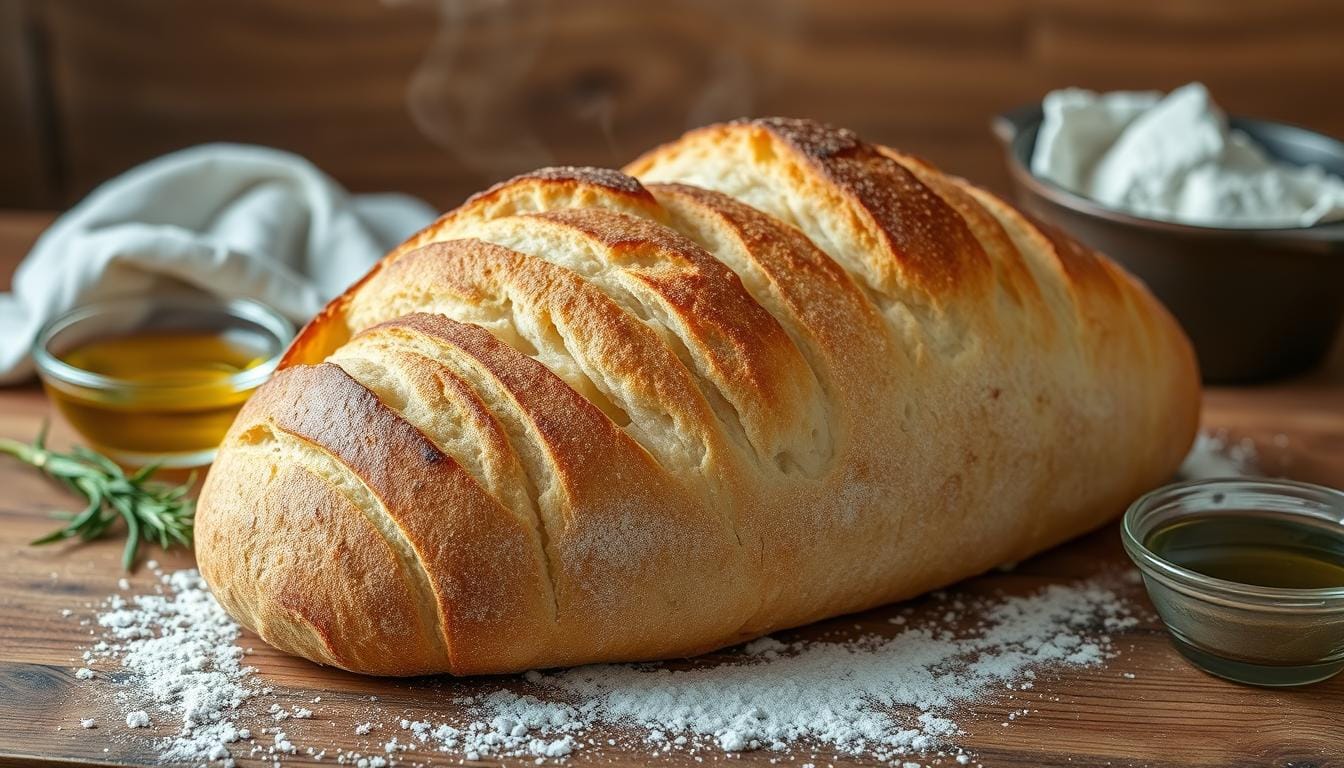
Storing homemade bread right can make it stay fresh and tasty longer. Using good bread storage tips helps keep your Italian bread fresh. Learning how to freeze bread keeps its great taste and texture.
How to Keep Your Bread Fresh
Choosing the right storage method is key to keeping homemade bread fresh. Here are some tips to help:
- Use a paper bag to store bread on the counter. This method helps retain freshness better than plastic.
- Consider a bread box with ventilation holes. This allows for proper air circulation, preventing mold while keeping the bread soft.
- For crusty loaves, keep them unwrapped for up to a day at room temperature. This maintains a crispy crust.
- Stay clear of storing bread on top of the refrigerator. Heat from appliances can accelerate staling.
- Reusable bread bags offer an eco-friendly storage solution, helping to prolong the life of your bread.
Freezing Your Italian Bread for Later Use
Freezing is a great way to keep your bread fresh longer. For freezing bread, here are a few useful tips:
- Slice your bread before freezing. This makes it convenient to take out only what you need.
- Wrap bread in plastic or foil to retain moisture while freezing.
- For optimal results, freeze individual portions to ensure easy reheating.
- When you’re ready to enjoy your frozen bread, simply toast slices directly from the freezer for a freshly baked experience.
- For whole loaves, thaw in the refrigerator overnight for the best taste and texture.
With these tips, you can enjoy your homemade bread for longer. Proper storage and freezing keep your Italian bread fresh and delicious every time.
with kitchen utensils and jars of ingredients.
Storage Method | Freshness Retention | Comments |
Paper Bag | Moderate | Best for short-term, maintains crust. |
Plastic Wrap | Good | Retains moisture but can soften crust. |
Freezing | Excellent | Long-term storage; slice for convenience. |
Refrigerator | Poor | Causes staling; only use in humid conditions. |
Ways to Enjoy Your Crusty Italian Bread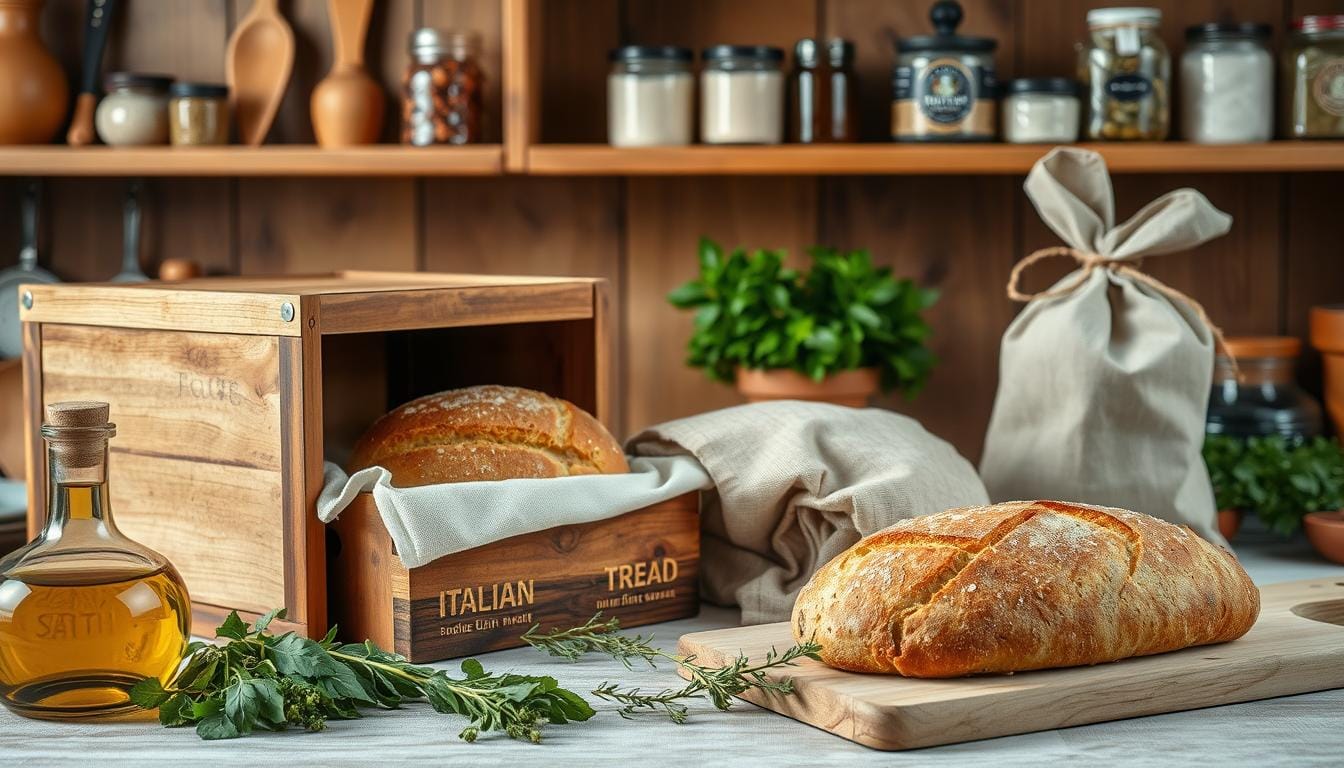
Crusty Italian bread is a treasure trove of flavors. It’s perfect for enhancing meals or enjoyed on its own. Each way of enjoying it brings out its best, making every bite a delight.
Pairing with Olive Oil and Dips
Pairing Italian bread with olive oil and dips is a simple yet satisfying choice. The smooth olive oil complements the bread’s crustiness. Adding a bit of balsamic vinegar adds a zesty kick. You can also try:
- Hummus
- Pesto
- Olive tapenade
- Homemade aioli
These combinations not only make your bread experience better but also let you explore different tastes. It shows how versatile crusty bread can be.
Using as a Base for Bruschetta
Crusty Italian bread is ideal for bruschetta. Toast the bread until it’s golden, then top it with fresh ingredients. Try these:
- Diced tomatoes, basil, and mozzarella
- Roasted bell peppers and feta cheese
- Avocado with sea salt and chili flakes
These toppings add flavor and texture, making the bread even more enjoyable.
Incorporating into Meals: Soups and Sauces
Crusty Italian bread is also great in meals. It’s perfect as a side for soups, soaking up the flavors. It’s also great as a garnish for stews or as a base for sauces. Try these:
- Serve with minestrone or tomato basil soup
- Pair with a rich beef stew
- Use for sopping up creamy sauces or gravies
Enjoying Italian bread in these ways shows how versatile and delicious it can be. Whether alone or with a meal, it’s always a treat.
Variations of the Classic Italian Bread Recipe
Exploring Italian bread variations opens a world of creativity and flavor. You can make your homemade bread your own by adding simple, yet flavorful ingredients. These additions not only enhance the taste but also make the bread more versatile in the kitchen.
Adding Herbs or Cheese for Extra Flavor
Adding herbs like rosemary, thyme, or basil can give your dough amazing aromas and earthy flavors. Cheese is also a great addition—Parmesan, mozzarella, or feta can add richness and complexity. These changes create a flavorful twist, perfect for enjoying fresh or toasting.
Transforming into Sub Sandwich Buns
Want to make your Italian bread more versatile? Try shaping it into sub sandwich buns. This adaptation makes the perfect base for delicious sandwiches. With its crusty exterior and soft interior, the bread highlights every filling. Experiment with different toppings and fillings—the options are limitless!
Conclusion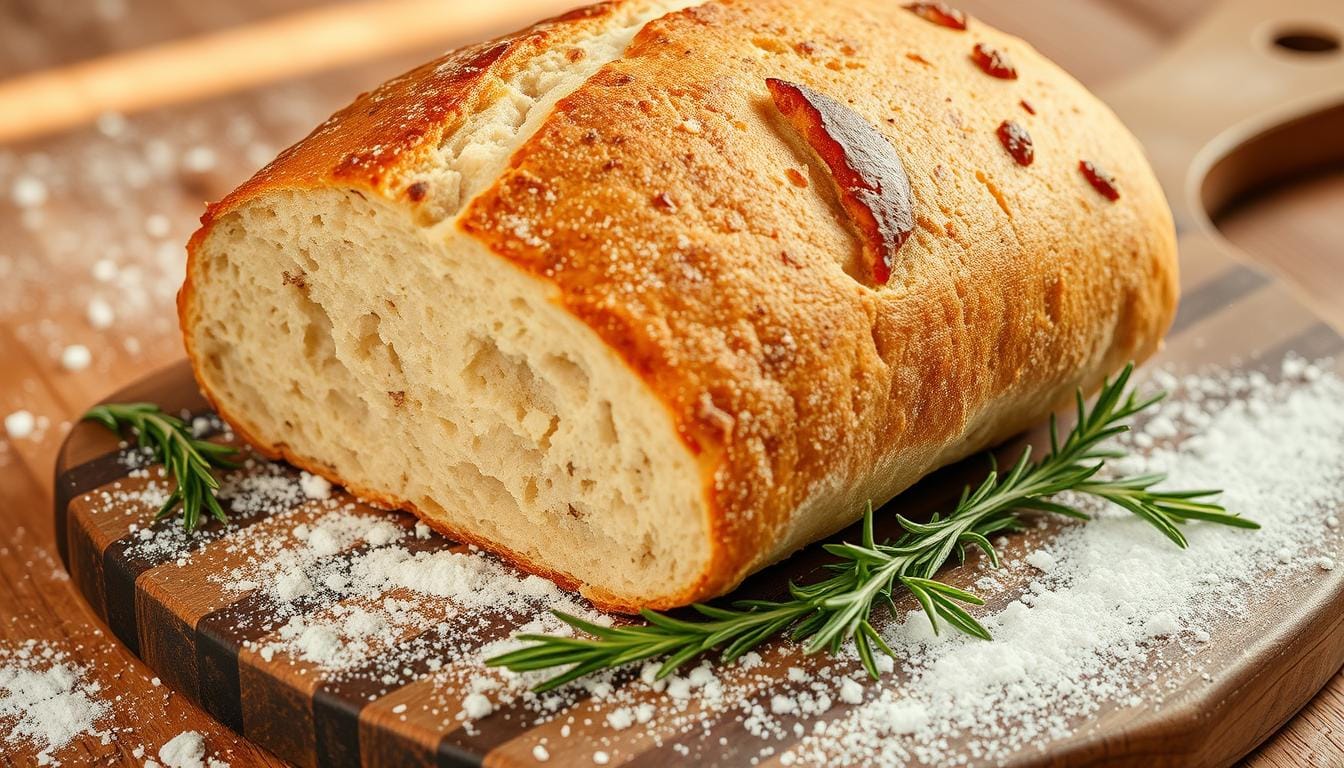
Making homemade Italian bread is a rewarding and tasty activity for anyone. You only need simple ingredients like warm water, yeast, flour, and olive oil. This will help you make 2 large loaves of crusty bread that everyone will love.
The recipe summary in this article covers key techniques. These steps include mixing, allowing the dough to rise, and baking it properly. These steps are crucial for a great result.
Learning to make bread lets you control what goes into it. You can choose healthier options and explore new flavors. You can add herbs to make it more rustic or use it for sandwiches.
Enjoying the process of making bread is just as important as the bread itself. It becomes a special tradition in your kitchen. Personalize your recipe by trying out new techniques and variations.
With a bit of practice, homemade Italian bread will become a favorite in your family. It’s perfect for sharing and celebrating at every meal. Start baking today and discover the magic of homemade bread.
FAQ
What makes crusty Italian bread different from other types of bread?
Crusty Italian bread has a thick, chewy crust and a soft inside. This is different from French bread, which is lighter. Its rustic look comes from old baking ways and special ingredients.
What are the key ingredients required for making Italian bread?
To make crusty Italian bread, you need good bread flour, yeast, salt, and water. Bread flour with more protein makes the bread chewy and strong.
How can I ensure my yeast is fresh for bread baking?
Check yeast freshness by mixing a teaspoon of sugar with warm water (110°F to 115°F) and yeast. If it bubbles and froths in 5-10 minutes, it’s ready.
What are some tips for achieving a crispy crust on my bread?
For a crispy crust, bake in a Dutch oven first. It traps steam for a crust. Scoring the dough before baking also helps the crust.
How should I store my homemade Italian bread?
Keep your bread in a paper bag or a clean towel to stay fresh for days. For longer, slice and freeze in airtight bags to keep quality.
Can I customize my Italian bread recipe with herbs or cheese?
Yes! Add fresh herbs like rosemary or thyme, or shredded cheese for flavor. This lets you make it your own.
What are some common mistakes to avoid when baking crusty bread?
Avoid expired yeast, wrong measurements, and bad kneading. Use fresh yeast, measure right, and knead well for best results.
How can I enjoy my crusty Italian bread?
Enjoy it many ways! Dip in olive oil, top with bruschetta, or serve with soups and sauces. It’s perfect for meals.

